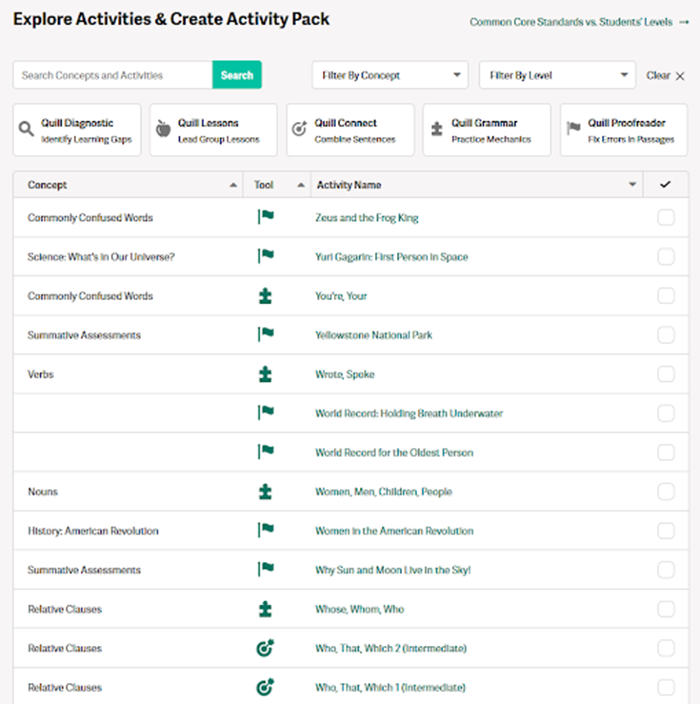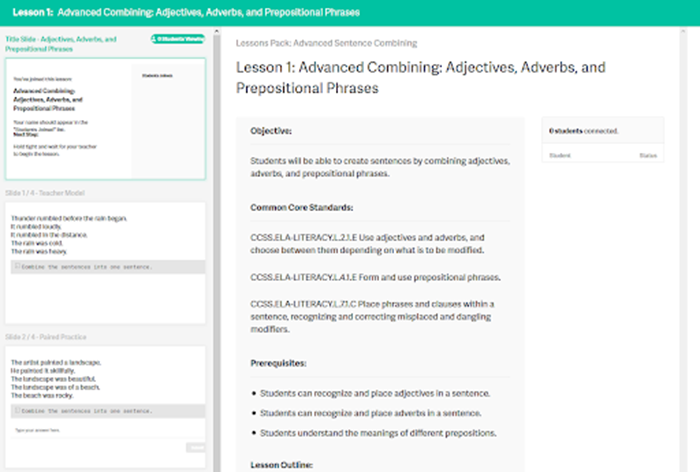Quill.org Adds Personalized Writing Support to any Course
Writing is a quintessential cross-curricular skill for students in technical as well as pre-university programs; college students turn in written work in most, if not all, of their courses. In order to acquire, consolidate and perfect their writing skills, students need sustained support and practice across courses. In reality, this does not always prove to be possible because of the amount of field-specific content to cover, as well as the time required to provide students with meaningful feedback on their writing. Quill.org alleviates some of these pain points by setting students up with a personalized program of learning and practice activities based on an automated diagnostic and their teacher’s recommendations.
What is Quill.org?
Although Quill.org, launched in 2014, was initially designed to cater specifically to K-12 students in the United States, it has since been expanded with tools and content that also help college and university students improve their writing, whether they are native speakers or speakers of English as a second or foreign language. It currently provides 4 tools that enable students to build writing, grammar, and proofreading skills, with more tools under development:
- Quill Diagnostic
- This question and task-based tool takes about 20-25 minutes to complete and identifies pain points students need to work on. It generates a personalized learning plan based on the student’s performance.
- Quill Grammar
- This tool has over 150 sentence-based writing activities to help students practice basic grammar skills. Each activity is designed to take 10 minutes or less.
- Quill Connect
- This tool helps students advance from sentence fragments and run-on sentences to complex and well-structured sentences. Students combine multiple ideas into a single sentence and receive instant feedback.
- Quill Proofreader
- Students work on their editing skills by proofreading passages. Over 100 different excerpts are currently available. Students receive personalized feedback and consolidation exercises based on their results.
Apart from these tools that analyze students’ grammar and writing skills, the platform contains over 40 hours of instruction in the form of lessons and tutorials covering grammar and writing-related topics. Quill is an open source organization rooted in a large community of developers and educators, and teachers can contribute content to expand the wealth of lessons already available. In August 2018, the platform reached the milestone of one million users. Both teacher and student accounts are entirely free.
Signing Up and Setting Up
The signup procedure is quick and streamlined. After selecting they want to create a teacher or a student account, users are invited to provide their full name and select a username and password. The platform also allows users to register using their Google credentials, and is compatible with Google Classroom.
After creating an account, teachers are presented with a checklist that facilitates readying their use of the platform with their students:
- The first step is to create a classroom. This makes it easy to group students, either based on the different classes you teach, or any other criterion; for instance, their level of writing or the issues you want them to work on. All students work individually; the classroom structure simply facilitates assigning tasks and activities to multiple students and follow up on their progress. A class code is automatically generated. This can be shared with students to allow them to join the group you have created.
- Students can be invited in different manners. The first is to share a class code, as mentioned above. This requires students to sign up individually beforehand. Student accounts can also be created automatically by connecting the platform with your Google Classroom, or manually by entering your students’ first and last names. In this case, their username become “first name.last name@class code” and their default password is their last name.
- Once your students have accounts and are grouped into classes, you can assign an entry diagnostic or you can directly assign tasks and activity packs readily available on the platform. These options are detailed in the next section.
- Finally, you can customize lessons or build your own activity pack by selecting relevant items from the platform’s library. This allows for even more personalization.
Once a class has been created, it is possible to invite co-teachers from the Manage Classes tab. This is particularly useful as part of a program-based approach, to allow all teachers of a given program to follow up on the progress of the students they accompany in their respective courses.

Overview of the Home screen and initial checklist.
Note that if you do not wish to follow up on your students’ work and progress, students can simply create a user account and take the entry diagnostic to receive personalized lesson recommendations and work entirely independently. Their student account also gives them access to the 4 analytical tools.
Entry Diagnostic
In order for students to truly benefit from Quill’s potential, their experience on the platform should start with one of the available entry diagnostic tests, which can be assigned from the Home tab. At the moment, 2 versions of the diagnostic are available – one tailored to native speakers and another for non-native speakers. Other types of diagnostic activities are currently being developed.
When students complete the diagnostic, the platform automatically generates an 8-week individualized learning plan for each student. As a teacher, you can assign the automatically generated recommendations, or you can modify these activities by adding or omitting certain topics before assigning the activity packs to your students.

Start screen of the diagnostic. Quill’s tone and feedback is always positive.
Activities and Activity Packs
At any point, teachers can also assign additional activities to individual students or the entire class. This can be done in 2 ways. From the Assign Activities tab, you can either select a featured activity pack, containing a selection of materials on a particular grammar or writing topic, or you can explore all activities to assign individual tasks or create your own pack.

Activity packs are topic based. The presentation tiles indicate the level of difficulty, the number of activities included, as well as the suggested duration.

Individual activities can be organized according to topic (concept) or type. It is also possible to search for keywords or filter specific levels of difficulty.
Activities take the shape of different types of individual exercises or group lessons (identified by an apple symbol). This is an important consideration when assigning an activity, because group lessons are designed to be led by the teacher. The teacher’s interface contains visual presentation slides as well as suggested instructions, while the student interface only displays the examples and exercises.
Example of an individual exercise

Example of a lesson (teacher view)
Offering Students a Path to Success in Writing
The beauty of Quill lies in the fact that it allows for teacher involvement and personalization while harnessing the power of artificial intelligence to give students instant feedback, even on open-ended responses, without teacher intervention. Its bite-sized activities can be used in the classroom, but also constitute an excellent opportunity for students to work on specific grammar and writing-related topics outside of class. Unlike many other websites that offer free grammar practice, Quill makes students feel that the learning path set out is specific and relevant to them, after they have completed the initial diagnostic. This makes the platform meaningful for everyone who wants to write clearly and accurately, regardless of their proficiency level or first language.

